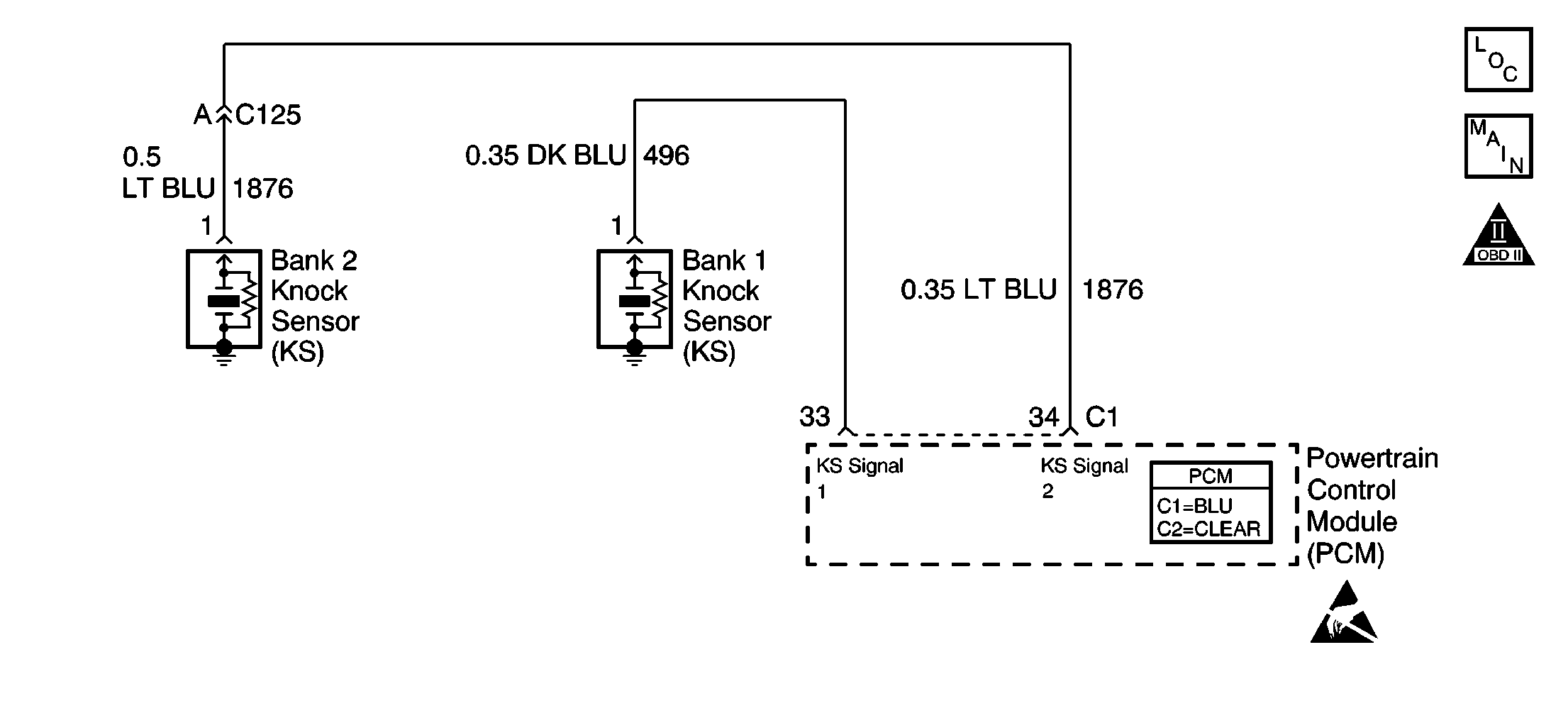
Circuit Description
The powertrain control module (PCM) contains integrated Knock Sensor (KS) Diagnostic Circuitry. Input signals from the knock sensors are used to detect engine detonation, allowing the PCM to retard ignition control (IC) spark timing based on the amplitude and frequency of the KS signal being received. The knock sensors produce an AC signal under all engine operating conditions. The PCM calculates an average voltage of each knock sensor's signal and takes instantaneous signal voltage readings. The PCM uses the instantaneous signal voltage readings to determine the state of the knock sensor circuitry. If the Knock Sensor system is operating normally, the PCM should monitor instantaneous KS signal voltage readings varying outside a voltage range above and below the calculated average voltage. If PCM detects a knock sensor 1 signal voltage within the calculated average voltage range, DTC P0327 will set.
Conditions for Running the DTC
| • | No TP Sensor, VSS, CKP, MAF, or ECT Sensor DTCs set. |
| • | Engine coolant temperature is more than 75°C (167°F). |
| • | Throttle angle is more than 3 percent. |
| • | Engine load is more than 20 percent. |
| • | Engine speed is between 1000-4000 RPM. |
| • | Maximum system spark retard is less than 15 degrees. |
| • | System voltage is more than 9 volts. |
Conditions for Setting the DTC
The PCM detects a knock sensor 1 signal voltage within the calculated average voltage range for at least 10 seconds.
Action Taken When the DTC Sets
| • | The PCM will illuminate the malfunction indicator lamp (MIL) during the second consecutive trip in which the diagnostic test has been run and failed. |
| • | The PCM will store conditions which were present when the DTC set as Freeze Frame/Failure Records data. |
Conditions for Clearing the MIL/DTC
| • | The PCM will turn OFF the malfunction indicator lamp (MIL) during the third consecutive trip in which the diagnostic has run and passed. |
| • | The history DTC will clear after 40 consecutive warm-up cycles have occurred without a malfunction. |
| • | The DTC can be cleared by using a scan tool. |
Diagnostic Aids
Inspect for the following conditions:
Misrouted harness -- Inspect the knock sensor harness to ensure that it is not routed too close to high voltage wires such as spark plug leads.
Many situations may lead to an intermittent condition. Perform each inspection or test as directed.
Important: : Remove any debris from the connector surfaces before servicing a component. Inspect the connector gaskets when diagnosing or replacing a component. Ensure that the gaskets are installed correctly. The gaskets prevent contaminate intrusion.
| • | Loose terminal connection |
| - | Use a corresponding mating terminal to test for proper tension. Refer to Testing for Intermittent Conditions and Poor Connections , and to Connector Repairs in Wiring Systems for diagnosis and repair. |
| - | Inspect the harness connectors for backed out terminals, improper mating, broken locks, improperly formed or damaged terminals, and faulty terminal to wire connection. Refer to Testing for Intermittent Conditions and Poor Connections , and to Connector Repairs in Wiring Systems for diagnosis and repair. |
| • | Damaged harness--Inspect the wiring harness for damage. If the harness inspection does not reveal a problem, observe the display on the scan tool while moving connectors and wiring harnesses related to the sensor. A change in the scan tool display may indicate the location of the fault. Refer to Wiring Repairs in Wiring Systems for diagnosis and repair. |
| • | Inspect the powertrain control module (PCM) and the engine grounds for clean and secure connections. Refer to Wiring Repairs in Wiring Systems for diagnosis and repair. |
If the condition is determined to be intermittent, reviewing the Snapshot or Freeze Frame/Failure Records may be useful in determining when the DTC or condition was identified.
Test Description
The numbers below refer to the step numbers on the diagnostic table.
-
This step ensures that the malfunction is present.
-
If sent here from Symptoms, proceed with the diagnostic table.
Step | Action | Values | Yes | No |
|---|---|---|---|---|
1 | Did you perform the Powertrain On Board Diagnostic (OBD) System Check? | -- | ||
|
Important: If a mechanical engine knock can be heard, repair the engine mechanical problem before proceeding with this diagnostic. Refer to Engine Noise Diagnosis in Engine Mechanical.
Does the DTC reset? | -- | |||
Does the DTC reset? | -- | Go to Diagnostic Aids | ||
4 |
Did you find and correct the condition? | -- | ||
5 |
Did you find and correct the condition? | -- | ||
6 | Replace the knock sensor. Refer to Knock Sensor Replacement . Is the action complete? | -- | -- | |
7 |
Does the DTC reset? | -- | System OK |
